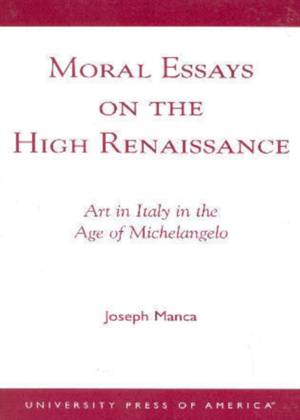
Door een staking bij bpost kan je online bestelling op dit moment iets langer onderweg zijn dan voorzien. Dringend iets nodig? Onze winkels ontvangen jou met open armen!
- Afhalen na 1 uur in een winkel met voorraad
- Gratis thuislevering in België vanaf € 30
- Ruim aanbod met 7 miljoen producten
Door een staking bij bpost kan je online bestelling op dit moment iets langer onderweg zijn dan voorzien. Dringend iets nodig? Onze winkels ontvangen jou met open armen!
- Afhalen na 1 uur in een winkel met voorraad
- Gratis thuislevering in België vanaf € 30
- Ruim aanbod met 7 miljoen producten
Zoeken
Moral Essays on the High Renaissance
Art in Italy in the Age of Michelangelo
Joseph Manca
Paperback | Engels
€ 104,95
+ 209 punten
Uitvoering
Omschrijving
Moral Essays on the High Renaissance consist of critical essays on the art and thought of major figures of sixteenth-century Italian Renaissance art. Looking at these artists from an ethical point of view, these provocative essays set out to discover and describe the moral basis of High Renaissance art. Important areas of focus include the paintings and sculpture of Michelangelo, the artistic style and sense of the life of Raphael, and the ethical approach of the Cinquecento biographer Giorgio Vasari. Consideration is given also to the worldly, graceful art of Leonardo da Vinci and the painterly hedonism of the Venetians. The volume concludes with a semi-autobiographical essay that restates the underlying moral principles behind the earlier chapters. The book is well illustrated with numerous black-and-white reproductions of important works of High Renaissance art and architecture.
Specificaties
Betrokkenen
- Auteur(s):
- Uitgeverij:
Inhoud
- Aantal bladzijden:
- 256
- Taal:
- Engels
Eigenschappen
- Productcode (EAN):
- 9780761820574
- Verschijningsdatum:
- 21/08/2001
- Uitvoering:
- Paperback
- Formaat:
- Trade paperback (VS)
- Afmetingen:
- 137 mm x 213 mm
- Gewicht:
- 294 g

Alleen bij Standaard Boekhandel
+ 209 punten op je klantenkaart van Standaard Boekhandel
Beoordelingen
We publiceren alleen reviews die voldoen aan de voorwaarden voor reviews. Bekijk onze voorwaarden voor reviews.











